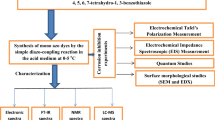Abstract
A series of polyfunctional organic compounds, 1-propenyl- and 1-allyl-2-propargyloxy-3-aminomethylbenzenes containing simultaneously an aminomethyl group and fragments with С=С and С≡С bonds, were prepared in high yield (77.6–94%) by Mannich ternary condensation of 2-propenyl- and 2-allylphenols and their p-methyl-substituted derivatives with formaldehyde and secondary amines (diethylamine, piperidine, and morpholine), followed by the reaction of the products with propargyl bromide. The structures of the compounds were confirmed by the NMR spectra. The compounds were studied as inhibitors of acid corrosion of St3 steel and as antimicrobial additives to cutting fluids. 1-Propenyl-2-propargyloxy-3-diethylaminomethylbenzene showed the highest protective performance. At its concentration of 0.01 and 0.05 g L–1, the degree of corrosion protection of St3 steel in 0.5 М Н2SO4 was 92.0 and 99.6% (at 25°C) and 70.0 and 98.7% (at 60°C), respectively. 1-Propenyl- and 1-allyl-2-propargyloxy-3-aminomethylbenzenes (in 0.25–1% concentrations) showed only bactericidal properties, whereas the p-methyl-substituted derivative, 1-methyl-3-allyl-4-propargyloxy-5-morpholinomethylbenzene, showed high bactericidal and fungicidal properties simultaneously. 1-Propenyl- and 1-allyl-2-propargyloxy-3-aminomethylbenzenes surpass the known antimicrobial additive, 8-hydroxyquinoline, in the bactericidal performance at identical concentrations, and 1-methyl-3-allyl-4-propargyloxy-5-morpholinomethylbenzene surpasses it in both bactericidal and fungicidal performance.
Similar content being viewed by others
REFERENCES
Veliyev, V.G., Chalabiyeva, A.Z., Shatirova, M.I., Vezirova, I.A., and Gadjiyeva, M.I., Petrol. Chem., 2010, vol. 50, no. 6, pp. 484–488. https://doi.org/10.1134/S0965544110060137
Kudryavtsev, D.B., Panteleeva, A.R., Yurina, A.V., Voloshina, A.D., Lukashenko, S.S., Zobov, V.V., Khodyrev, Y.P., Mirgorodskaya, A.B., and Zakharova, L.Y., Petrol. Chem., 2011, vol. 51, no. 4, pp. 293–298. https://doi.org/10.1134/S096554411103008X
Al-Nowaiser, F.M., Abdallah, M., and El-Mossalamy, E.H., Chem. Technol. Fuels Oils, 2012, vol. 47, pp. 453–463.
Devyatnik, P.N., Vestn. Mosk. Gos. Tekh. Univ., 2007, vol. 10, no. 4, pp. 613–616.
Plotnikova, M.D., Tiunov, I.A., Novikov, A.A., Khrenova, A.A., and Shein, A.B., Chem. Technol. Fuels Oils, 2015, vol. 51, no. 3, pp. 252–256.
Patent RU 2384567, Publ. 2010.
Shcherban, M.G., Batueva, T.D., and Radushev, A.V., Russ. J. Appl. Chem., 2009, vol. 82, no. 1, pp. 57–61. https://doi.org/10.1134/S1070427209010121
Finzgar, M. and Jackson, J., Corros. Sci., 2014, vol. 86, pp. 17–41. https://doi.org/10.1016/j.corsci.2014.04.044
Maharramov, A.M., Bayramov, M.R., Agayeva, M.A., Mehdiyeva, G.M., and Mammadov, I.G., Russ. Chem. Rev., 2015, vol. 84, no. 12, pp. 1258–1278. https://doi.org/10.1070/RCR4437
Huang Chuanjin and Wang Mingcun, Can. J. Chem. Eng., 2016, vol. 94, no. 1, pp. 41–45. https://doi.org/10.1002/cjce.22361
Mehdiyeva, G.M., Maharramov, A.M., Bayramov, M.R., Agayeva, M.A., Hosseinzadeh, Sh.B., and Hasanova, G.M., Petrol. Chem., 2015, vol. 55, no. 3, pp. 247–251. https://doi.org/10.1134/S0965544115030081
Guliyev, A.M., Khimiya i tekhnologiya prisadok k maslam i toplivam (Chemistry and Technology of Additives to Oils and Fuels), Leningrad: Khimiya, 1985.
ACKNOWLEDGMENTS
The authors are sincerely grateful to Director of the Guliyev Institute of Chemistry of Additives, National Academy of Sciences of Azerbaijan, Acad. Vagif Mejid ogli Farzaliyev for the assistance in performing the studies of the synthesized compounds as antimicrobial additives to cutting fluids at the institute headed by him.
Funding
The study was financially supported by the Foundation for Science Development at the President of Azerbaijan Republic (project no. EIF/MQM/Elm-Tehsil-1-2016-1(26)-71/01/3).
Author information
Authors and Affiliations
Corresponding author
Ethics declarations
The authors declare that they have no conflict of interest.
Rights and permissions
About this article
Cite this article
Bayramov, M.R., Askarova, G.M., Mehdiyeva, G.M. et al. Synthesis and Study of 1-Alkenyl-2-propargyloxy-3-aminomethylbenzenes as Acid Corrosion Inhibitors and Antimicrobial Additives to Cutting Fluids. Russ J Appl Chem 93, 1638–1645 (2020). https://doi.org/10.1134/S1070427220110026
Received:
Revised:
Accepted:
Published:
Issue Date:
DOI: https://doi.org/10.1134/S1070427220110026




